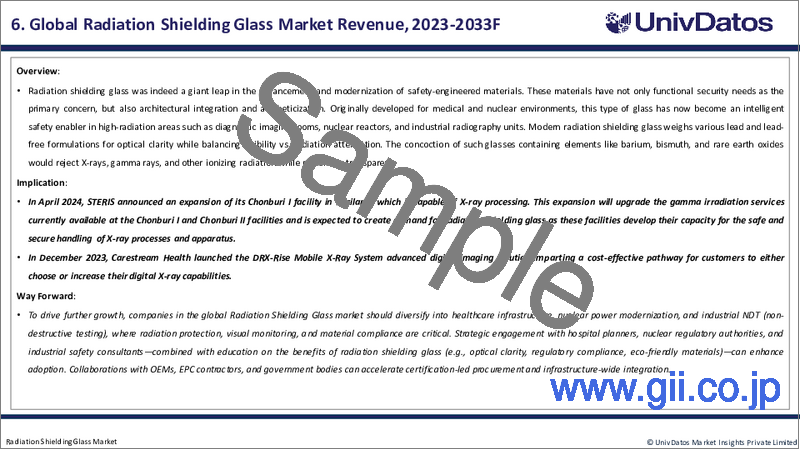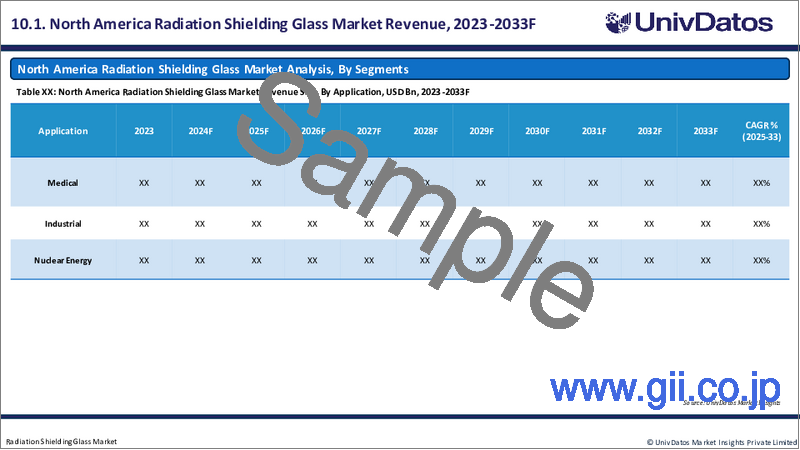|
|
市場調査レポート
商品コード
1747343
放射線遮蔽ガラス市場:現状分析と予測(2025-2033年)Radiation Shielding Glass Market: Current Analysis and Forecast (2025-2033) |
||||||
カスタマイズ可能
|
|||||||
| 放射線遮蔽ガラス市場:現状分析と予測(2025-2033年) |
|
出版日: 2025年05月01日
発行: UnivDatos Market Insights Pvt Ltd
ページ情報: 英文 138 Pages
納期: 即日から翌営業日
|
全表示
- 概要
- 目次
放射線遮蔽ガラス市場は予測期間(2025-2033年)内に5.91%の堅調な成長率を示しています。放射線遮蔽ガラスは、安全設計材料の進歩と近代化において、まさに大きな飛躍となりました。これらの材料は、機能的な安全性ニーズが第一の関心事であるだけでなく、建築的統合や美観化も重要な課題です。もともとは医療や原子力環境のために開発されたこの種のガラスは、現在では画像診断室、原子炉、工業用X線撮影装置などの放射線量の高いエリアにおいて、インテリジェントな安全性を実現するものとなっています。現代の放射線遮蔽ガラスは、視認性と放射線減衰のバランスを取りながら、光学的透明性を確保するために様々な鉛や鉛フリーの配合を計量しています。バリウム、ビスマス、希土類酸化物などの元素を含むこのようなガラスの調合は、透明性を保ちながらX線、ガンマ線、その他の電離放射線を拒絶します。STERISは、X線処理が可能なタイのチョンブリI施設を2024年4月に拡張すると発表しました。この拡張により、現在チョンブリIとチョンブリIIの施設で提供しているガンマ線照射サービスがアップグレードされ、X線プロセスやX線装置を安全かつ確実に取り扱う能力がこれらの施設で開発されるため、放射線遮蔽ガラスの需要創出が期待されます。
放射線遮蔽ガラス市場はタイプ別に鉛ガラスと鉛フリーガラスに区分されます。2024年には、鉛フリーガラス市場が優位を占め、予測期間を通じてその主導的地位を維持すると予想されます。鉛フリーのソリューションへのパラダイムシフトは、環境規制や持続可能性への取り組みが各国で高まっているためであり、こうしたガラスはより環境に優しいソリューションとして販売されています。鉛フリーの放射線遮蔽ガラスには、バリウム、ビスマス、その他の重金属酸化物などが含まれ、同等の遮蔽を提供するが、有毒な鉛元素を含まないです。このような変容と、画像診断、核医学、クリーンエネルギー研究の急速な拡大により、安全性、光学性能、アーキテクチャを融合した、より高い遮蔽ソリューションへの需要が高まっています。モジュール化された透明な医療インフラという新しい世界では、遮蔽ガラスは機能だけでなく、デザイン的にも透明な遮蔽ソリューションとして使用されています。さらに、医療や原子力分野の安全性に関する規制が強化される中、メーカーは軽量でカスタマイズ可能な透明性の高い遮蔽材料に投資しています。このような観点から、放射線遮蔽ガラスは、安全性、持続可能性、柔軟なデザインを具現化した、病院、研究所、制御室、産業施設向けのソリューションになりつつあります。
放射線タイプにより、放射線遮蔽ガラス市場はX線遮蔽、ガンマ線遮蔽、中性子遮蔽に区分されます。X線遮蔽分野は2024年に最大の市場シェアを占め、予測期間中も同様の推移が予想されます。この優位性は、医療診断、歯科、工業検査におけるX線画像アプリケーションによってもたらされます。X線防護用の放射線遮蔽ガラスは、高い透明性と光学的透明性を持ち、強力な減衰特性を備えているため、病院、研究室、制御室の観察窓の材料として適しています。安全基準が厳しくなり、画像診断の必要性が世界中で拡大し続けているため、メーカーは鉛を含まないビスマスやバリウムをベースとしたガラスなど、より高度な素材を放射線遮蔽に使用し始めています。このようなガラスは放射線防護に優れ、環境にも優しいです。これらのガラスは軽量で衝撃に強く、成形も容易であるため、視認性、衛生性、モジュール性が同等に重視される現代の医療施設の設計に適しています。持ち運びが可能で小型の機械が多く使用されるようになったことで、要求に合わせてカスタマイズされた遮蔽ガラスの需要が増加するという大きな変化をもたらしました。現在、これらの素材の進化は、より多くの設計オプション、持続可能な建築技術の取り込み、設置における複雑さの軽減を可能にしています。このため、公共および民間の医療インフラにおけるこれらの製品の使用はさらに強化されています。
放射線遮蔽ガラス市場は用途別に医療、産業、原子力に区分されます。2024年では、医療分野が市場を独占しており、予測期間中も主導的地位を維持すると見られています。これは主に、X線、CT、透視などの病院や診断センターベースの画像診断技術の持続的な開発に起因します。放射線遮蔽ガラスは、安全な観察を可能にし、看護師や患者に最高レベルの放射線防護を提供することで、医療現場で活躍しています。放射線遮蔽ガラスの現代的な用途としては、もちろん安全性を損なうことなく、開放的で透明な医療施設のレイアウトにおいて、美的要素や積極的な建築的特徴となることが挙げられます。ヘルスケアシステムが精密診断と低侵襲処置に移行するにつれ、超透明、鉛フリー、鉛フリーの遮蔽ガラスに対する需要は著しい伸びを示しています。一方、臨床現場における放射線安全規制の高まりに伴い、公共および民間の医療インフラにおける設置数が増加しています。市場は、医療インフラ開発に対する世界の推進力とともに、モジュール式の移動式診断装置への注目が高まっていることに、さらなる推進力を見出しています。先進経済諸国と新興経済諸国の間で医療用画像診断がますます高度化する中、放射線遮蔽ガラスは診断セットの中核に位置し、安全でコンプライアンスに適合し、患者に優しいものとなっています。2023年12月、ケアストリームヘルスはDRX-RiseモバイルX線システム先進デジタル画像ソリューションを発売しました。
放射線遮蔽ガラス市場をより深く理解するために、市場は北米(米国、カナダ、その他北米地域)、欧州(ドイツ、英国、フランス、イタリア、スペイン、その他欧州地域)、アジア太平洋地域(中国、日本、インド、韓国、その他アジア太平洋地域)、世界のその他の地域における世界のプレゼンスに基づいて分析されています。北米の放射線遮蔽ガラス市場は2024年に世界の放射線遮蔽ガラス市場を席巻し、予測期間中もその地位を維持すると予測されています。この優位性は、同地域の高度な医療インフラ、多数の画像診断手技、放射線安全性に関する厳格な規制遵守が主な要因です。米国では、病院をアップグレードし、放射線安全建材を統合するための投資が継続的に行われており、放射線遮蔽ガラスは医科・歯科の画像診断室、腫瘍科、移動診断ユニットなどの標準オプションとなっています。さらに、高度に発達した原子力発電所や、高度に技術的な放射線防護材料を必要とするいくつかの研究センターの存在が、むしろ高い需要を高めています。さらに、環境に優しい鉛フリーの遮蔽ソリューションへの嗜好の高まりや、ヘルスケアや防衛分野で採用されているモジュール式構造アプローチも、市場の成長を補完しています。また、同地域の主要メーカーによる継続的な技術革新や健康、安全促進を目的とした政府政策により、北米は放射線遮蔽ガラスにとって成熟した重要な市場となっています。
同市場に参入している主な企業には、Corning Incorporated、SCHOTT AG、日本電気硝子株式会社、RAY-BAR ENGINEERING CORP、Nuclear Lead Co.Ltd.、Radiation Protection Products, Inc.、Lead Glass Pro.、MAVIG GmbH、Midland Lead、MarShield Custom Radiation Shieldingなどです。
目次
第1章 市場イントロダクション
- 市場の定義
- 主な目的
- ステークホルダー
- 制限事項
第2章 調査手法または前提条件
- 調査プロセス
- 調査手法
- 回答者プロファイル
第3章 エグゼクティブサマリー
- 業界要約
- セグメント別見通し
- 市場成長の強さ
- 地域展望
第4章 市場力学
- 促進要因
- 機会
- 抑制要因
- 動向
- PESTEL分析
- 需要側分析
- 供給側分析
- 合併と買収
- 投資シナリオ
- 業界考察:主要スタートアップ企業とその独自の戦略
第5章 価格分析
- 地域価格分析
- 価格に影響を与える要因
第6章 世界の放射線遮蔽ガラス市場収益、2023-2033年
第7章 市場洞察:タイプ別
- 鉛ガラス
- 鉛フリーガラス
第8章 市場洞察:放射線タイプ別
- X線遮蔽
- ガンマ線遮蔽
- 中性子遮蔽
第9章 市場洞察:用途別
- 医療
- 産業
- 原子力
第10章 市場洞察:地域別
- 北米
- 米国
- カナダ
- その他北米地域
- 欧州
- ドイツ
- 英国
- フランス
- イタリア
- スペイン
- その他欧州地域
- アジア太平洋地域
- 中国
- 日本
- インド
- 韓国
- その他アジア太平洋地域
- 世界のその他の地域
第11章 バリューチェーン分析
- 限界分析
- 市場参入企業リスト
第12章 競合情勢
- 競合ダッシュボード
- 競合の市場ポジショニング分析
- ポーターファイブフォース分析
第13章 企業プロファイル
- Corning Incorporated
- SCHOTT AG
- Nippon Electric Glass Co., Ltd.
- RAY-BAR ENGINEERING CORP
- Nuclear Lead Co. Inc.
- Radiation Protection Products, Inc.
- Lead Glass Pro.
- MAVIG GmbH
- Midland Lead
- MarShield Custom Radiation Shielding
第14章 頭字語と前提条件
第15章 付録
The Radiation Shielding Glass Market is witnessing a robust growth rate of 5.91% within the forecast period (2025- 2033F). Radiation shielding glass was indeed a giant leap in the advancement and modernization of safety-engineered materials. These materials have not only functional security needs as the primary concern, but also architectural integration and aestheticization. Originally developed for medical and nuclear environments, this type of glass has now become an intelligent safety enabler in high-radiation areas such as diagnostic imaging rooms, nuclear reactors, and industrial radiography units. Modern radiation shielding glass weighs various lead and lead-free formulations for optical clarity while balancing visibility vs. radiation attenuation. The concoction of such glasses containing elements like barium, bismuth, and rare earth oxides would reject X-rays, gamma rays, and other ionizing radiation while remaining transparent. STERIS announced an expansion of its Chonburi I facility in Thailand, which is capable of X-ray processing, in April 2024. This expansion will upgrade the gamma irradiation services currently available at the Chonburi I and Chonburi II facilities and is expected to create demand for radiation shielding glass as these facilities develop their capacity for the safe and secure handling of X-ray processes and apparatus.
Based on type, the radiation shielding glass market is segmented into Lead Glass and Lead-Free Glass. In 2024, the lead-free glass market dominated and is expected to maintain its leading position throughout the forecast period. The paradigm shift toward lead-free solutions is due to the growing environmental regulations and sustainability efforts across countries, and such glass is marketed as a greener solution. In this spectrum, lead-free radiation shielding glass includes barium, bismuth, and other heavy metal oxides, which offer comparable shielding but lack the toxic lead element. This transformation and the rapid expansion of diagnostic imaging, nuclear medicine, and clean-energy research have increased the demand for higher shielding solutions that merge safety, optical performance, and architecture. With the new world of modular and transparent healthcare infrastructure, shielding glass is used not just for function but for design-transparent shielding solutions. Furthermore, manufacturers, amid a tightening regulatory environment around safety in medical and nuclear arenas, invest in lighter, customizable, and highly transparent shielding materials. From this perspective, radiation shielding glass is becoming the solution for hospitals, laboratories, control rooms, and industrial facilities, embodying safety, sustainability, and flexible design.
Based on radiation type, the radiation shielding glass market is segmented into X-Ray Shielding, Gamma Ray Shielding, and Neutron Shielding. The X-Ray shielding segment held the largest market share in 2024 and is expected to behave in the same fashion in the forecast period. This dominance is driven by X-ray imaging applications in medical diagnostics, dentistry, and industrial inspections. Radiation shielding glass for X-ray protection has high transparency and optical clarity, apart from a strong attenuation property that makes it an appropriate material for observation windows in hospitals, laboratories, and control rooms. With safety standards becoming stringent and the need for imaging being ever-expanding across the world, manufacturers have started using more sophisticated materials such as lead-free bismuth or barium-based glass for radiation shielding. Such glass provides good radiation protection and is environmentally friendly. These glasses are light, impact-resistant, and can be shaped easily, making them suitable for the design of modern medical facilities where the elements of visibility, hygiene, and modularity are given equal importance. The elevated use of portable and small-sized machines has brought tremendous changes in increasing demand for shielding glass solutions customized to requirements. At present, the evolution of these materials is allowing for more design options, incorporating sustainable building technologies, and reduced complexities in installation. This has further enhanced the use of these products in both public and private healthcare infrastructure.
Based on applications, the radiation shielding glass market is segmented into Medical, Industrial, and Nuclear Energy. In 2024, the medical segment dominated the market and is expected to maintain its leading position throughout the forecast period. This is mainly attributable to the persistent development of the hospital and diagnostic center-based diagnostic imaging technologies such as X-ray, CT, and fluoroscopy. Radiation shielding glass works in medical environments by permitting safe observation and providing the highest level of radiation protection to nurses and patients. Modern purposes of radiation shielding glass can include being an aesthetic element and an active architectural feature in open and transparent medical facility layouts without compromising on safety, of course. With the healthcare system devolving into precision diagnostics and minimally invasive procedures, the demand for super-clear, lead, and lead-free shielding glass has seen tremendous growth; on the other hand, with the rise in radiological safety regulations across clinical settings, installations have witnessed a growing number across both public and private health infrastructures. The market finds additional impetus in the increasing thrust laid on modular, mobile diagnostic units, along with the concurrent global thrust on healthcare infrastructure development. With medical imaging soaring higher and farther between developed and developing economies, radiation shielding glass sits at the core of the diagnostic set-up, making it safe, compliant, and friendly to patients. In December 2023, Carestream Health launched the DRX-Rise Mobile X-Ray System advanced digital imaging solution-imparting a cost-effective pathway for customers to either choose or increase their digital X-ray capabilities.
For a better understanding of the market of the radiation shielding glass market, the market is analyzed based on its worldwide presence in countries such as North America (The US, Canada, and Rest of North America), Europe (Germany, The UK, France, Italy, Spain, Rest of Europe), Asia-Pacific (China, Japan, India, South Korea, Rest of Asia-Pacific), Rest of World. The North America radiation shielding glass market dominated the global radiation shielding glass market in 2024 and is forecasted to remain in this position in the forecast period. This dominance is primarily led by the region's advanced healthcare infrastructure, a large number of diagnostic imaging procedures, and stringent regulatory compliance concerning radiation safety. In the United States, investments have been made consistently to upgrade hospitals, integrate radiation-safe construction materials, wherein the radiation shielding glass has become a standard option across medical and dental imaging rooms, oncology departments, and mobile diagnostic units. Further, the presence of highly developed nuclear power and several research centers that require highly technical radiation protection materials enhances a rather high demand. Growth in the market is further supplemented by increased preference for environmentally friendly lead-free shielding solutions and the modular construction approach adopted in the healthcare and defense sectors. Also, continuous technological innovation undertaken by key manufacturers in the region and health as well and safety-promoting government policies make North America a mature and crucial market for radiation shielding glass.
Some of the major players operating in the market include Corning Incorporated, SCHOTT AG, Nippon Electric Glass Co., Ltd., RAY-BAR ENGINEERING CORP, Nuclear Lead Co. Inc., Radiation Protection Products, Inc., Lead Glass Pro., MAVIG GmbH, Midland Lead, and MarShield Custom Radiation Shielding.
TABLE OF CONTENTS
1.Market Introduction
- 1.1. Market Definitions
- 1.2. Main Objective
- 1.3. Stakeholders
- 1.4. Limitation
2.Research Methodology Or Assumption
- 2.1. Research Process of the Radiation Shielding Glass Market
- 2.2. Research Methodology of the Radiation Shielding Glass Market
- 2.3. Respondent Profile
3.Executive Summary
- 3.1. Industry Synopsis
- 3.2. Segmental Outlook
- 3.2.1. Market Growth Intensity
- 3.3. Regional Outlook
4.Market Dynamics
- 4.1. Drivers
- 4.2. Opportunity
- 4.3. Restraints
- 4.4. Trends
- 4.5. PESTEL Analysis
- 4.6. Demand Side Analysis
- 4.7. Supply Side Analysis
- 4.7.1. Merger & Acquisition
- 4.7.2. Investment Scenario
- 4.7.3. Industry Insights: Leading Startups and Their Unique Strategies
5.Pricing Analysis
- 5.1. Regional Pricing Analysis
- 5.2. Price Influencing Factors
6.Global Radiation Shielding Glass Market Revenue (USD Bn), 2023-2033F
7.Market Insights By Type
- 7.1. Lead Glass
- 7.2. Lead-Free Glass
8.Market Insights By Radiation Type
- 8.1. X-Ray Shielding
- 8.2. Gamma Ray Shielding
- 8.3. Neutron Shielding
9.Market Insights By Application
- 9.1. Medical
- 9.2. Industrial
- 9.3. Nuclear Energy
10.Market Insights By Region
- 10.1. North America
- 10.1.1. The US
- 10.1.2. Canada
- 10.1.3. Rest of North America
- 10.2. Europe
- 10.2.1. Germany
- 10.2.2. The UK
- 10.2.3. France
- 10.2.4. Italy
- 10.2.5. Spain
- 10.2.6. Rest of Europe
- 10.3. Asia-Pacific
- 10.3.1. China
- 10.3.2. Japan
- 10.3.3. India
- 10.3.4. South Korea
- 10.3.5. Rest of Asia-Pacific
- 10.4. Rest of World
11.Value Chain Analysis
- 11.1. Marginal Analysis
- 11.2. List of Market Participants
12.Competitive Landscape
- 12.1 Competition Dashboard
- 12.2. Competitor Market Positioning Analysis
- 12.3. Porter Five Forces Analysis
13.Company Profiles
- 13.1. Corning Incorporated
- 13.1.1. Company Overview
- 13.1.2. Key Financials
- 13.1.3. SWOT Analysis
- 13.1.4. Product Portfolio
- 13.1.5. Recent Developments
- 13.2. SCHOTT AG
- 13.3. Nippon Electric Glass Co., Ltd.
- 13.4. RAY-BAR ENGINEERING CORP
- 13.5. Nuclear Lead Co. Inc.
- 13.6. Radiation Protection Products, Inc.
- 13.7. Lead Glass Pro.
- 13.8. MAVIG GmbH
- 13.9. Midland Lead
- 13.10. MarShield Custom Radiation Shielding





